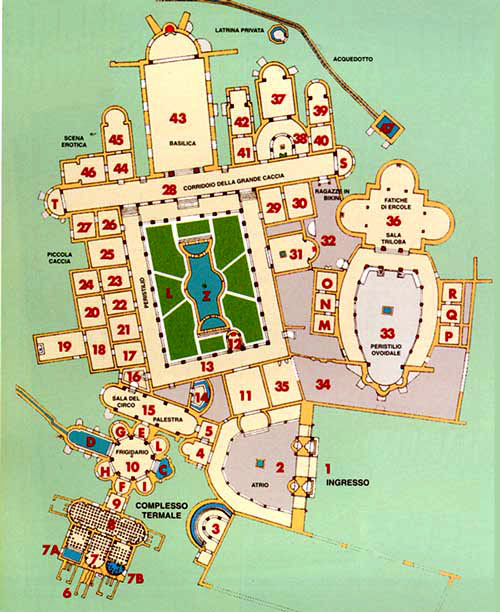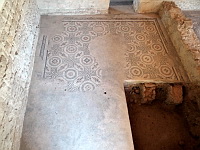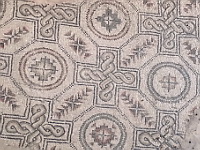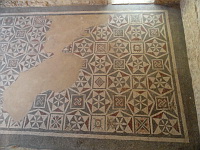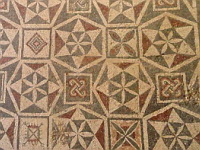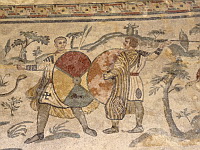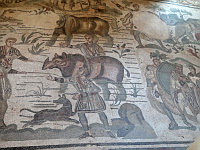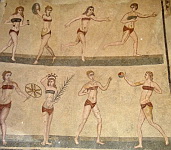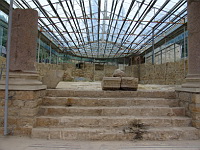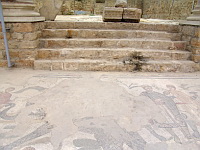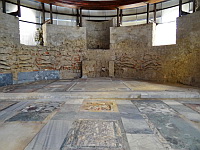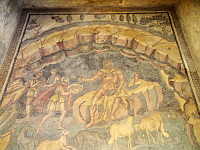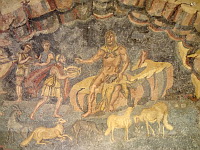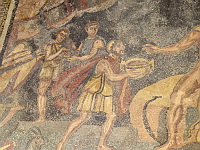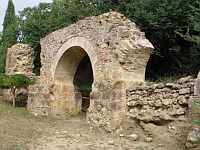The Roman Villa del Casale
The Villa del Casale is a late Roman villa whose remains are located a few kilometers (about 4) from Piazza Armerina, in the Casale district, on the provincial road to Barrafranca. The Villa is located at the foot of Mount Mangone, it was built around the third or fourth century AD
on an area already occupied since the IIsec. from a "rustic villa" and in the center of a rural settlement within a large estate. The structure was built following the course of the land so it is structured in terraces on three different levels and spread over an area of about 4.000. In December 1997, the Villa was included in the World Heritage List.
Historical notes and brief description
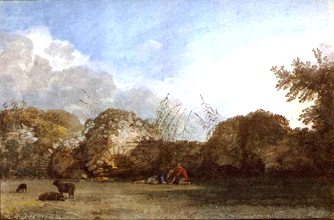 The Villa was built around the third or fourth century AD on an area already occupied since the second century. from a "rustic villa" and in the center of a rural settlement within a large estate. The Villa, or parts of it, although with various functional adaptations were also inhabited in the Arab period (X-XI century) and Norman period (XI-XII century). name of Plàtia was destroyed in 1160-61 and rebuilt after a few years in its current location in Piazza Armerina. The Villa was abandoned and nothing remained of it but ruins, even if in the vicinity, agricultural housing settlements did not have to completely disappear. In the fifteenth century there was a center known as Casale, from which the Villa took its current name. The ruins of the Villa were visible at the time of Jean Pierre Houel who visited Sicily in 1776-1779 and who was able to represent the ruins in one of his watercolors. After the first excavations in 1812 (Sabatino del Muto) and 1881 (Luigi Pappalardo), a first excavation campaign was conducted in 1929 by Paolo Orsi, who discovered the first mosaic (the labors of Hercules), and a second one, conducted in various shots from 1935 to 1939 by Giuseppe Cultrera, under the patronage of Biagio Pace, brought to light the whole triclinium with the elliptical portico in front of it. But the real excavations that have brought to light most of the Villa took place in (1950-54), under the direction of Gino Vinicio Gentili. In the 70s the restorations that led to the Plexiglas roof system designed by the architect. Franco Minissi. The excavation is still to be considered incomplete, because the dependencies of the villa remain to be discovered and are still buried in the surroundings. In recent years it has been underway, by the excavation mission of the La Sapienza University of Rome directed by prof. Patrizio Pensabene, an excavation campaign in the southern area, which has brought to light an ancient medieval town. In 2006 a second phase of restoration begins which involves the replacement of the previous roof. In 2012 the Villa was reopened to the public, even if some rooms are not yet fully open to visitors.
The Villa was built around the third or fourth century AD on an area already occupied since the second century. from a "rustic villa" and in the center of a rural settlement within a large estate. The Villa, or parts of it, although with various functional adaptations were also inhabited in the Arab period (X-XI century) and Norman period (XI-XII century). name of Plàtia was destroyed in 1160-61 and rebuilt after a few years in its current location in Piazza Armerina. The Villa was abandoned and nothing remained of it but ruins, even if in the vicinity, agricultural housing settlements did not have to completely disappear. In the fifteenth century there was a center known as Casale, from which the Villa took its current name. The ruins of the Villa were visible at the time of Jean Pierre Houel who visited Sicily in 1776-1779 and who was able to represent the ruins in one of his watercolors. After the first excavations in 1812 (Sabatino del Muto) and 1881 (Luigi Pappalardo), a first excavation campaign was conducted in 1929 by Paolo Orsi, who discovered the first mosaic (the labors of Hercules), and a second one, conducted in various shots from 1935 to 1939 by Giuseppe Cultrera, under the patronage of Biagio Pace, brought to light the whole triclinium with the elliptical portico in front of it. But the real excavations that have brought to light most of the Villa took place in (1950-54), under the direction of Gino Vinicio Gentili. In the 70s the restorations that led to the Plexiglas roof system designed by the architect. Franco Minissi. The excavation is still to be considered incomplete, because the dependencies of the villa remain to be discovered and are still buried in the surroundings. In recent years it has been underway, by the excavation mission of the La Sapienza University of Rome directed by prof. Patrizio Pensabene, an excavation campaign in the southern area, which has brought to light an ancient medieval town. In 2006 a second phase of restoration begins which involves the replacement of the previous roof. In 2012 the Villa was reopened to the public, even if some rooms are not yet fully open to visitors.
The Villa has four nuclei connected to each other:
* monumental entrance with three arches with polygonal courtyard (1-2);
* thermal complex (3-10);
* central body of the villa, organized around a quadrangular peristyle courtyard, with a garden with a central basin (11-31);
* Triclinium preceded by an ovoid peristyle surrounded in turn by another group of rooms (33, 34, 36);
Many of the halls of the residence have the floor with figured mosaics in colored tiles.
For a detailed description and related images, see the area below.
|
XNUMXst Group 1- Entrance 2 - Polygonal courtyard 3 - Large Latrine 5 - Vestibule of the Baths II ° Group 11 - Vestibule of the Adventus 17 - Room of the Norman oven 18 - Internal room 19 - Kitchen 20 - Hall of Dance
|
VI ° Group 43 - The great Basilica 45 - Fruit Cubicle 47 - Aqueduct + private latrine |
III ° Group 21 - Star Mosaic Room 22 - Lost Mosaic Room 23 - Hall of Seasons 24 - Hall of the Fishermen Cupids 25 - Diaeta of the Small Hunt 26 - Mosaic room with octagons 27 - Mosaic room with squares XNUMXth Group 28 - Corridor of the great hunt 31 - Diaeta of Orpheus XNUMXth Group |
Below is a detailed description of the individual areas.
[wc_accordion collapse = "1 ″ leaveopen =" 0 ″ layout = "box"]
[wc_accordion_section title = "First Group: from n. 1 to no. 10"]
1 - Entrance (hostium)
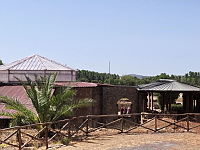
2 - Polygonal courtyard
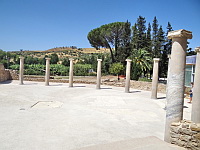
The thermal complex has the typical layout and layout of Roman baths and is constitutive of the gymnasium, the large exedra-shaped latrine, the anointing room from the thermal baths: frigidarium, tepidarium and calidarium
3 - Large Latrine
On the left de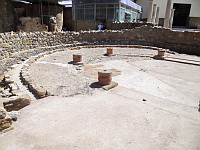
4 - Aedicule of Venus
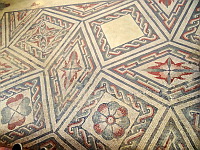
5 - Vestibule of the Baths
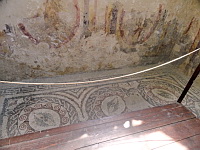
6 - Praefurnia
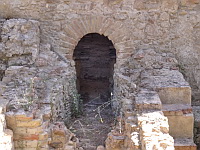
7 - Calidarium
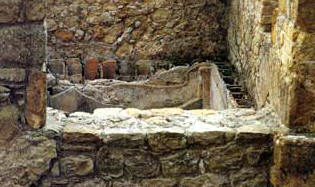 Il calidarium (o calidarium, from caldus o calidus = "Hot") was the part of the spa intended for hot water baths and steam baths. The calidarium of the Roman Vila del Casale consisted of three rooms close to the ovens (6): two with a tub for hot baths, one without a tub, probably used for steam baths (sauna).
Il calidarium (o calidarium, from caldus o calidus = "Hot") was the part of the spa intended for hot water baths and steam baths. The calidarium of the Roman Vila del Casale consisted of three rooms close to the ovens (6): two with a tub for hot baths, one without a tub, probably used for steam baths (sauna).
8 - Tepidarium
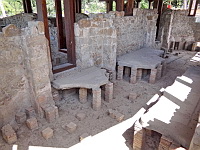
9 - Hall of Unctions
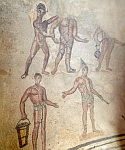
10 - Frigidarium
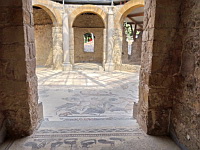
[/ wc_accordion_section]
[wc_accordion_section title = "Second Group: from n. 11 to no. 20"]
11 - Vestibule of the Adventus
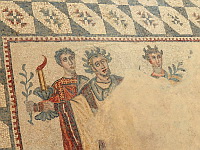
12 - Temple of the lares and 13 - Peristyle
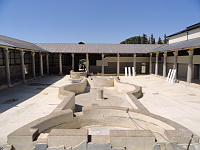 The vestibule leads to the rectangular peristyle with 32 marble columns surmounted by Corinthian capitals. The corridors of the Peristyle have a well-preserved floor consisting of a series of laurel wreaths including heads of animals of many different species (felines, antelopes, bulls, wild goats, horses, onagers, deer, rams, an elephant and an ostrich. ). The orientation of the heads changes in two points: at the entrance from the vestibule, and at the foot of the staircase leading to the complex of the apsidal hall on the eastern side.
The vestibule leads to the rectangular peristyle with 32 marble columns surmounted by Corinthian capitals. The corridors of the Peristyle have a well-preserved floor consisting of a series of laurel wreaths including heads of animals of many different species (felines, antelopes, bulls, wild goats, horses, onagers, deer, rams, an elephant and an ostrich. ). The orientation of the heads changes in two points: at the entrance from the vestibule, and at the foot of the staircase leading to the complex of the apsidal hall on the eastern side. Inside the Peristyle, in front of the entrance, there is a small one aedicule with apse (small temple), the “Sacello dei Lari”, framed by two columns of the peristyle and with a geometric mosaic floor.
14 - Small Latrine
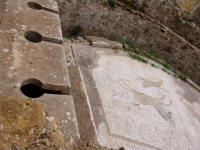 The small private latrine or latrine was available to the guests of the Villa. Trapezoidal in shape, it has a floor depicting animals. Along the wall there were seats with a central hole. The seats currently visible are a concrete reconstruction of the marble originals.
The small private latrine or latrine was available to the guests of the Villa. Trapezoidal in shape, it has a floor depicting animals. Along the wall there were seats with a central hole. The seats currently visible are a concrete reconstruction of the marble originals.
15 - Circus hall or gym
Corridor ending in apses at both ends and decorated with the mosaic of the Circus. There is represented the Circus Maximus of Rome, full of details, with a chariot race in progress, won by the faction Prasina or "greens". The Romans loved the chariot races and cheered on the charioteers, who wore the colors of four factions: red, green, white and blue. In the apse to the right of the temples of divinities: Jupiter Ercole and Dea Roma; immediately afterwards servants in the act of handing helmets and whips to the charioteers. This corridor was probably used for indoor gymnastics.
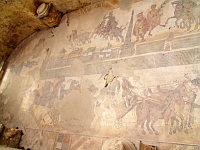 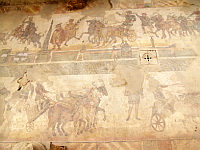 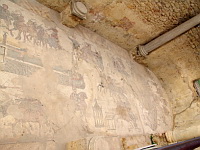 |
16 - Vestibule of the Domina
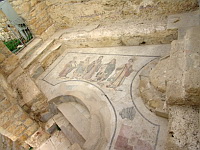
17 - Room of the Norman oven
Service area with mosaic floor with geometric designs: octagons with circular bands inside, braids in the shape of crosses and hexagons with flowers. In the Norman period, the part of the floor that was cut housed a furnace for cooking the clay used to build vases.
|
|
|
18 - Internal room
Service area for the kitchen (19) with mosaic floor with geometric designs: squares and hexagons inside which there are six-pointed stars enclosing six-petaled flowers.
19 - Kitchen
Rectangular environment, does not have a mosaic floor, has a rectangular basin and a masonry counter.
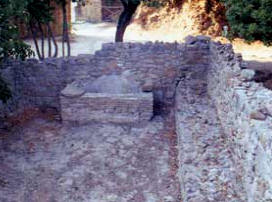
20 - Hall of Dance
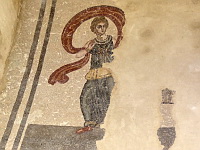
[/ wc_accordion_section]
[wc_accordion_section title = "Third Group: from n. 21 to no. 27"]
21 - Star Mosaic Room
Service area with mosaic floor with geometric designs with two-square star motifs and flowers.
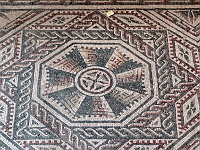 |
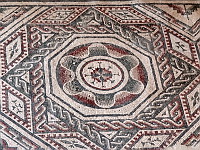 |
22 - Lost Mosaic Room
Rectangular room probably intended for guests. The floor mosaic is lost.
23 - Hall of Seasons
Quadrangular environment with a geometric-figurative mosaic floor. The scene is made up of large polychrome hexagons containing female and male figures representing the four seasons, fish and birds.
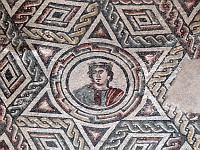 |
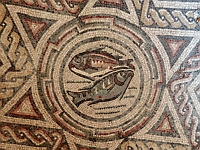 |
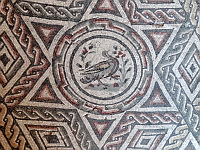 |
24 - Hall of the Fishermen Cupids
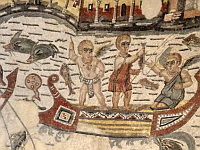
25 - Diaeta of the Small Hunt
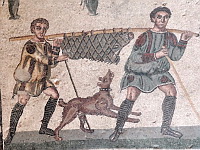
-
in the first register from above, a hunter and his dogs in pursuit of a fox;
-
in the second register, a sacrifice to Diana, between two men carrying a bound boar on their shoulders and a third carrying a hare;
-
in the third register, two men spying on some birds on the leaves of a tree, a vast scene with the owner's banquet with his attendants in the woods, a hunter in the act of hitting a hare with venabulum;
-
in the fourth I record the capture of three deer with a net and the killing of a wild boar that attacks a wounded hunter and the figures of two servants hidden behind the rock: one tries to hit the beast with a stone, the other touches the front.
26 - Mosaic room with octagons
Quadrangular environment with mosaic floor with geometric designs with octagonal motifs with concave sides generating circles and spindles.
27 - Mosaic room with squares
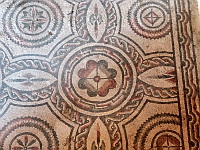
[/ wc_accordion_section]
[wc_accordion_section title = "Fourth Group: from n. 28 to no. 35 "]
28 - Corridor of the great hunt
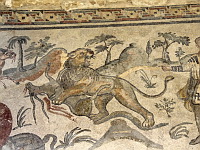
The floor mosaic features 7 scenes:
-
The first scene depicts captures of different animals: the panther, the antelope and the wild boar;
-
The second scene depicts a port town with a luxurious building in the background - perhaps a maritime villa -, a knight supervising the transport of a heavy load. Four men carry on their backs some beasts locked inside crates, an officer whips a slave and other servants drag ostriches and antelopes on a ship;
-
In the third scene, which is located in front of the entrance to the apsidal hall, a tract of land located between the two seas is depicted. In the center, a group of three characters observes the landing of animals from two ships coming from either side.
-
The fourth scene represents the embarkation of the animals in an eastern port, perhaps Egypt, as the presence of an elephant, a tiger and a dromedary would suggest. The hunters wear oriental-style breeches.
-
The fifth scene depicts the capture of rhinos, red flowers and characteristic pagoda buildings are visible.
-
In the sixth scene I know they see in the upper part a fight between wild beasts and a lion attacking a man. In the lower part there is a character, flanked by two soldiers with shields.
-
The seventh scene depicts the capture of a tiger. A crystal ball is thrown towards the tiger, the animal, seeing its own image reflected in the sphere, gets distracted, allowing the hunters to capture it. The last episode, quite singular, shows the capture of a griffin with a human bait.
29 - Mosaic room with squares
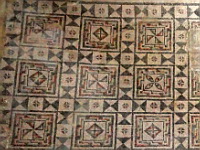
30 - Girls in Bikini Room
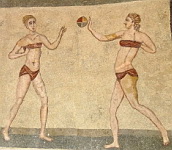
31 - Diaeta of Orpheus
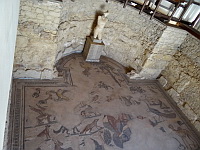
32 - Courtyard
Passage courtyard, connected the Great Basilica (43), the corridor of the great hunting (28) and the patronal apartments with the Triclinium (36)
33 - Ovoid peristyle
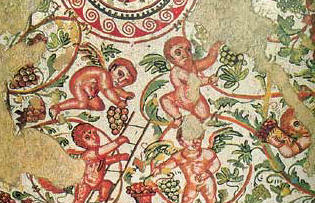 Ellipsoidal portico. At the bottom an apse with three niches which probably housed marble statues. In the center, the remains of a fountain. The porch floor features a mosaic with busts of animals: tigers, lions, wolves, deer, horses, etc.
Ellipsoidal portico. At the bottom an apse with three niches which probably housed marble statues. In the center, the remains of a fountain. The porch floor features a mosaic with busts of animals: tigers, lions, wolves, deer, horses, etc.
On the sides of the portico there are 6 small rooms: three on the south side (P, R, Q) with fishing scenes and three on the north side (M, N, O) with scenes relating to the grape harvest.
34 - Corridor between Peristyle and Ovoid Portico
Passage courtyard, connected the peristyle (13) with the Triclinium (36)
35 - The kitchen
Environment identified as a kitchen

[/ wc_accordion_section]
[wc_accordion_section title = "Fifth Group: from n. 36 to n. 42"]
36 - Triclinium
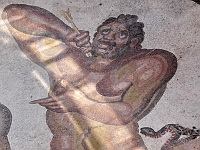
37 - Diaeta of Arion
A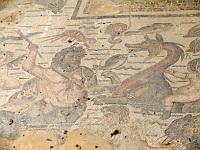
38 - Atrium with arcade in the hemicycle
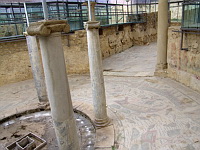
39 - Musicians and actors cubicle
 Rectangular room with apse, used as a bedroom (cubicle). In the mosaic floor of the apse two girls, seated on large baskets, intend to weave wreaths of roses; near them two small corbels full of flowers. On the floor of the room in front of it a mosaic divided into three registers: four players, assisted by a referee, in the first register; male and female actors who give life to a comic representation, in the second; and three characters, next to some instruments, you mean to another representation in the last register
Rectangular room with apse, used as a bedroom (cubicle). In the mosaic floor of the apse two girls, seated on large baskets, intend to weave wreaths of roses; near them two small corbels full of flowers. On the floor of the room in front of it a mosaic divided into three registers: four players, assisted by a referee, in the first register; male and female actors who give life to a comic representation, in the second; and three characters, next to some instruments, you mean to another representation in the last register
40 - Small Circus Vestibule
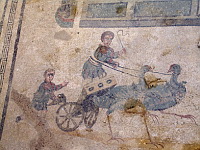
41 - Vestibule of Eros and Pan
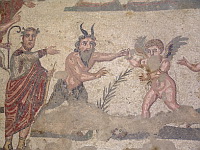
42 - Cubicle Children hunters
 Room with rectangular alcove. The mosaic of the floor is of a figurative type arranged on two registers with girls who collect roses and build garlands. In the alcove a scene of child hunters.
Room with rectangular alcove. The mosaic of the floor is of a figurative type arranged on two registers with girls who collect roses and build garlands. In the alcove a scene of child hunters.
[/ wc_accordion_section]
[wc_accordion_section title = "Sixth Group: from n- 43 to n. 47"]
43 - The great Basilica
Son the end side of the corridor of the Great Hunt, in the center, raised with four steps, there is a large apsidal hall, with a colonnaded entrance. The hall was intended as an area of representation and sumptuous receptions, very large and rectangular in shape, it retains only traces of the flooring with polychrome marble inlay. In the apse, the masonry stall where the throne rested.
|
43 The Great Basilica (2005)
|
43 The Great Basilica (2005)
|
43 The great Basilica
|
44 - Vestibule of Polyphemus
Room with mosaic floor representing the scene of Ulysses with Polyphemus: center Polyphemus seated on a boulder, on the left Ulysses, together with two companions, in the act of offering the Cyclops a cup full of wine; below sheep grazing or resting and in the background the encampments and the verdant countryside. On the walls there are figurative traces of frescoes
|
44 Vestibule of Polyphemus
|
44 Vestibule of Polyphemus
|
44 Vestibule of Polyphemus
|
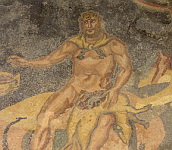 44 Vestibule of Polyphemus |
45 - Fruit Cubicle
Environment q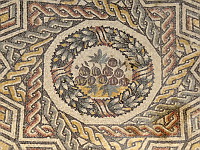
46 - Cubicle Erotic Scene
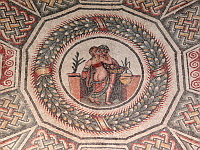
47 - Aqueduct
The raised aqueduct brought water directly to the spa complex. In the vicinity there is a small octagonal-shaped latrine.
[/ wc_accordion_section]
[/ wc_accordion]
[wp_ad_camp_1]
The Roman Villa del Casale


